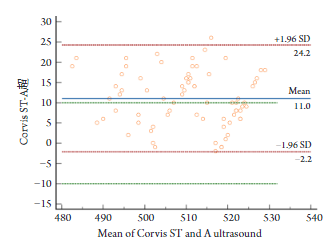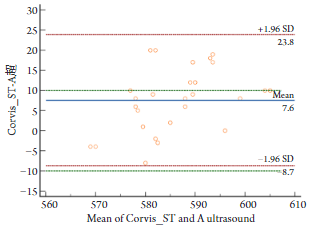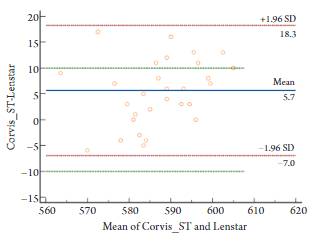1、Wong YL, Saw SM. Epidemiology of pathologic myopia in asia and worldwide[J]. Asia Pac J Ophthalmol (Phila), 2016, 5(6): 394-402.Wong YL, Saw SM. Epidemiology of pathologic myopia in asia and worldwide[J]. Asia Pac J Ophthalmol (Phila), 2016, 5(6): 394-402.
2、Ambrosio JRR, Ramos I, Luz A, et al. Dynamic ultra-high-speed Scheimpflug imaging for assessing corneal biomechanical properties[J]. RevBras Oftalmol, 2013, 72(2): 99-102.Ambrosio JRR, Ramos I, Luz A, et al. Dynamic ultra-high-speed Scheimpflug imaging for assessing corneal biomechanical properties[J]. RevBras Oftalmol, 2013, 72(2): 99-102.
3、Lee H, Kang DSY, Ha BJ, et al. Biomechanical properties of the cornea using a dynamic scheimpflug analyzer in healthy eyes[J]. Yonsei Med J, 2018, 59(9): 1115-1122.Lee H, Kang DSY, Ha BJ, et al. Biomechanical properties of the cornea using a dynamic scheimpflug analyzer in healthy eyes[J]. Yonsei Med J, 2018, 59(9): 1115-1122.
4、Hon Y, Wan K, Chen GZ, et al. Diurnal variation of corneal tangent modulus in normal Chinese[J]. Cornea, 2016, 35(12): 1600-1604.Hon Y, Wan K, Chen GZ, et al. Diurnal variation of corneal tangent modulus in normal Chinese[J]. Cornea, 2016, 35(12): 1600-1604.
5、Hamed-Azzam S, Briscoe D, Tomkins O, et al. Evaluation of intraocular pressure according to corneal thickness before and after excimer laser corneal ablation for myopia[J]. Int Ophthalmol, 2013, 33(4): 349-354.Hamed-Azzam S, Briscoe D, Tomkins O, et al. Evaluation of intraocular pressure according to corneal thickness before and after excimer laser corneal ablation for myopia[J]. Int Ophthalmol, 2013, 33(4): 349-354.
6、Viswanathan D, Goldberg I, Graham SL. Relationship of change in central corneal thickness to visual field progression in eyes with glaucoma[J]. Graefes Arch Clin Exp Ophthalmol, 2013, 251(6): 1593-1599.Viswanathan D, Goldberg I, Graham SL. Relationship of change in central corneal thickness to visual field progression in eyes with glaucoma[J]. Graefes Arch Clin Exp Ophthalmol, 2013, 251(6): 1593-1599.
7、Christensen A, Narváez J, Zimmerman G. Comparison of central corneal thickness measurements by ultrasound pachymetry, konan noncontact optical pachymetry, and orbscan pachymetry[J]. Cornea, 2008, 27(8): 862-865.Christensen A, Narváez J, Zimmerman G. Comparison of central corneal thickness measurements by ultrasound pachymetry, konan noncontact optical pachymetry, and orbscan pachymetry[J]. Cornea, 2008, 27(8): 862-865.
8、Hon Y, Lam AK. Corneal deformation measurement using Scheimpflug noncontact tonometry[J]. Optom Vis Sci, 2013, 90(1): e1-e8.Hon Y, Lam AK. Corneal deformation measurement using Scheimpflug noncontact tonometry[J]. Optom Vis Sci, 2013, 90(1): e1-e8.
9、祖培培, 王雁, 左彤, 等. 角膜生物力学眼压分析仪 Corvis ST 测量值的重复性与一致性研究[J]. 中华眼视光学与视觉科学杂志, 2013, 15(5): 261-265. 祖培培, 王雁, 左彤, 等. 角膜生物力学眼压分析仪 Corvis ST 测量值的重复性与一致性研究[J]. 中华眼视光学与视觉科学杂志, 2013, 15(5): 261-265.
10、 Study on repeatability and consistency of Corvis ST measured by corneal biomechanical intraocular pressure analyzer[J]. Chinese Journal of Optometry Ophthalmology and Visual Science, 2013, 15(5): 261-265. Study on repeatability and consistency of Corvis ST measured by corneal biomechanical intraocular pressure analyzer[J]. Chinese Journal of Optometry Ophthalmology and Visual Science, 2013, 15(5): 261-265.
11、Iskander NG, Anderson Penno E, Peters NT, et al. Accuracy of Orbscan pachymetry measurements and DHG ultrasound pachymetry in primary laser in situ keratomileusis and LASIK enhancement procedures[J]. J Cataract Refract Surg, 2001, 27(5): 681-685.Iskander NG, Anderson Penno E, Peters NT, et al. Accuracy of Orbscan pachymetry measurements and DHG ultrasound pachymetry in primary laser in situ keratomileusis and LASIK enhancement procedures[J]. J Cataract Refract Surg, 2001, 27(5): 681-685.
12、张日平, 孙丽霞, 王贤, 等. 三种仪器测量中央角膜厚度的对比研究[J]. 眼视光学杂志, 2009, 11(5): 364-367. 张日平, 孙丽霞, 王贤, 等. 三种仪器测量中央角膜厚度的对比研究[J]. 眼视光学杂志, 2009, 11(5): 364-367.
13、 A comparative study of three instruments for measuring central corneal thickness[J]. Chinese Journal of Optometry & Ophthalmology, 2009, 11(5): 364-367. A comparative study of three instruments for measuring central corneal thickness[J]. Chinese Journal of Optometry & Ophthalmology, 2009, 11(5): 364-367.
14、Bjelo? Ron?evi? M, Bu?i? M, Cima I, et al. Intraobserver and interobserver repeatability of ocular components measurement in cataract eyes using a new optical low coherence reflectometer[J]. Graefes Arch Clin Exp Ophthalmol, 2011, 249(1): 83-87.Bjelo? Ron?evi? M, Bu?i? M, Cima I, et al. Intraobserver and interobserver repeatability of ocular components measurement in cataract eyes using a new optical low coherence reflectometer[J]. Graefes Arch Clin Exp Ophthalmol, 2011, 249(1): 83-87.
15、沈政伟, 薛林平, 莫婷, 等. Lenstar LS900的临床应用进展[J]. 国际眼科杂志, 2012, 12(11): 2123-2125. 沈政伟, 薛林平, 莫婷, 等. Lenstar LS900的临床应用进展[J]. 国际眼科杂志, 2012, 12(11): 2123-2125.
16、 Clinical application progress of Lenstar LS900[J]. International Eye Science, 2012, 12(11): 2123-2125. Clinical application progress of Lenstar LS900[J]. International Eye Science, 2012, 12(11): 2123-2125.
17、Tappeiner C, Rohrer K, Frueh BE, et al. Clinical comparison of biometry using the non-contact optical low coherence reflectometer (Lenstar LS 900) and contact ultrasound biometer (Tomey AL-3000) in cataract eyes[J]. Br J Ophthalmol, 2010, 94(5): 666-667.Tappeiner C, Rohrer K, Frueh BE, et al. Clinical comparison of biometry using the non-contact optical low coherence reflectometer (Lenstar LS 900) and contact ultrasound biometer (Tomey AL-3000) in cataract eyes[J]. Br J Ophthalmol, 2010, 94(5): 666-667.
18、黄磊, 段宝萍, 胡琦. 角膜厚度的非接触式测量及进展研究[J]. 临床眼科杂志, 2010, 18(4): 380-383. 黄磊, 段宝萍, 胡琦. 角膜厚度的非接触式测量及进展研究[J]. 临床眼科杂志, 2010, 18(4): 380-383.
19、 Non contact measurement of corneal thickness and research progress[J]. Journal Of Clinical Ophthalmology, 2010, 18(4): 380-383. Non contact measurement of corneal thickness and research progress[J]. Journal Of Clinical Ophthalmology, 2010, 18(4): 380-383.
20、肖信, 刘伟民, 黄建忠, 等. 角膜生物力学分析仪测量近视患者中央角膜厚度和眼压的准确性评价[J].中华实验眼科杂志, 2016, 34(4): 340-344. 肖信, 刘伟民, 黄建忠, 等. 角膜生物力学分析仪测量近视患者中央角膜厚度和眼压的准确性评价[J].中华实验眼科杂志, 2016, 34(4): 340-344.
21、 Accuracy evaluation of corneal biomechanical analyzer in measuring central corneal thickness and intraocular pressure in patients with myopia[J]. Chinese Journal of Experimental Ophthalmology, 2016, 34(4): 340-344. Accuracy evaluation of corneal biomechanical analyzer in measuring central corneal thickness and intraocular pressure in patients with myopia[J]. Chinese Journal of Experimental Ophthalmology, 2016, 34(4): 340-344.
22、李跃祖, 李俊, 张洁莹, 等. Corvis ST和Pentacam联合诊断系统测量角膜厚度及眼压的临床观察[J]. 临床眼科杂志, 2020, 28(4): 341-346. 李跃祖, 李俊, 张洁莹, 等. Corvis ST和Pentacam联合诊断系统测量角膜厚度及眼压的临床观察[J]. 临床眼科杂志, 2020, 28(4): 341-346.
23、 Clinical observation of corneal thickness and intraocular pressure measured by Corvis ST and Pentacam combined diagnostic system[J]. Journal of Clinical Ophthalmology, 2020, 28(4): 341-346. Clinical observation of corneal thickness and intraocular pressure measured by Corvis ST and Pentacam combined diagnostic system[J]. Journal of Clinical Ophthalmology, 2020, 28(4): 341-346.
24、Yu A, Zhao W, Savini G, et al. Evaluation of central corneal thickness using corneal dynamic scheimpflug analyzer Corvis ST and comparison with Pentacam rotating scheimpflug system and ultrasound pachymetry in normal eyes[J]. J Ophthalmol, 2015, 2015: 767012.Yu A, Zhao W, Savini G, et al. Evaluation of central corneal thickness using corneal dynamic scheimpflug analyzer Corvis ST and comparison with Pentacam rotating scheimpflug system and ultrasound pachymetry in normal eyes[J]. J Ophthalmol, 2015, 2015: 767012.
25、Smedowski A, Weglarz B, Tarnawska D, et al. Comparison of three intraocular pressure measurement methods including biomechanical properties of the cornea[J]. Invest Ophthalmol Vis Sci, 2014, 55(2): 666-673.Smedowski A, Weglarz B, Tarnawska D, et al. Comparison of three intraocular pressure measurement methods including biomechanical properties of the cornea[J]. Invest Ophthalmol Vis Sci, 2014, 55(2): 666-673.
26、朱小敏, 张勇, 谢琳. Corvis ST在青光眼中测量中央角膜厚度和眼内压的临床研究[J]. 重庆医学, 2020, 49(21): 3556-3560. 朱小敏, 张勇, 谢琳. Corvis ST在青光眼中测量中央角膜厚度和眼内压的临床研究[J]. 重庆医学, 2020, 49(21): 3556-3560.
27、 Clinical study of Corvis ST in measuring central corneal thickness and intraocular pressure in glaucoma[J]. Chongqing Medicine, 2020, 49(21): 3556-3560. Clinical study of Corvis ST in measuring central corneal thickness and intraocular pressure in glaucoma[J]. Chongqing Medicine, 2020, 49(21): 3556-3560.
28、Niimi J, Tan B, Chang J, et al. Diurnal pattern of tear osmolarity and its relationship to corneal thickness and deswelling[J]. Cornea, 2013, 32(10): 1305-1310.Niimi J, Tan B, Chang J, et al. Diurnal pattern of tear osmolarity and its relationship to corneal thickness and deswelling[J]. Cornea, 2013, 32(10): 1305-1310.









